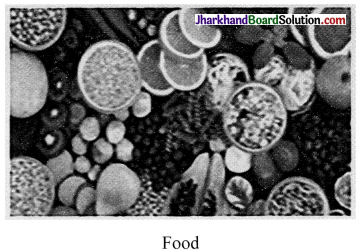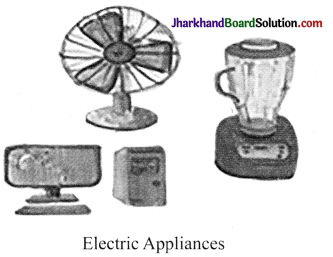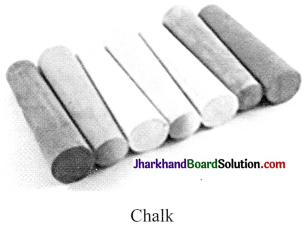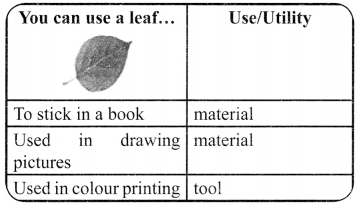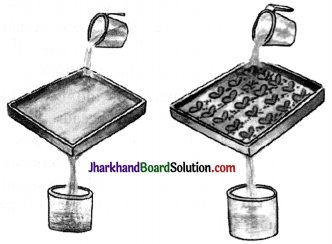JAC Board Class 8th Social Science Notes Geography Chapter 3 Mineral and Power Resources
→ A mineral is a naturally occurring substance that has a definite chemical composition.
- Minerals are not evenly distributed over the areas. They are concentrated in a particular area or rock formations.
- Some minerals are found in regions which are not easily accessible such as the Arctic ocean bed and Antarctica.
- Minerals are created by natural processes without any human interference. On the basis of their physical properties such as colour, density, hardness and chemical property such as solubility, they are classified and identified.
→ Types of Minerals:
- On earth, there are over three thousand different minerals.
- On the basis of composition, minerals are categorised as:
- Metallic minerals
- non-metallic minerals.
- Metals in raw form are present in metallic minerals.
- The hard substances that conduct heat and electricity and have a characteristic lustre or shine are known as metals. Iron ore, bauxite, manganese ore are some examples.
![]()
→ Metallic minerals are of two types:
- Ferrous minerals are such as iron ore, manganese and chromites contain iron.
- A non-ferrous mineral does not contain iron but may contain some other metal such as gold, silver, copper or lead.
→ Non-metallic minerals do not contain metals.
- Limestone, mica and gypsum are non- metallic minerals.
- The mineral fuels like coal and petroleum are also non-metallic minerals.
- Minerals can be extracted by mining, drilling or quarrying.
- Mining is the process of taking out minerals from rocks buried under the earth’s surface.
→ Mining is categorised into two:
- Open cast mining
- Shaft mining
→ In open-cast mining, minerals that lie at shallow depths are taken out by removing the surface layer.
- In shaft mining, deep bores known as shafts, have to be made to reach mineral deposits that lie at great depths.
- Petroleum and natural gas occur deep below the earth’s surface. Drilling is done to take them out and deep wells are bored.
- Quarrying is the method in which minerals that lie near the surface are simply dug out.
→ Distribution of Minerals:
- Metallic minerals are found in igneous and metamorphic rock formations that form large plateaus.
- Iron-ore in north Sweden, copper and nickel deposits in Ontario, Canada, iron, nickel, chromites and platinum in South Africa are some of the examples of minerals found in these rocks.
- Non-metallic minerals are found in sedimentary rock formations of plains and young fold mountains contain such as limestone.
- Limestone deposits of Caucasus region of France, manganese deposits of Georgia and Ukraine and phosphate beds of Algeria are some examples. Coal and petroleum, the mineral fuels are also found in the sedimentary strata.
→ Asia:
- China and India have large iron ore deposits. The continent produces more than half of the world’s tin.
- The world’s leading tin producers are China, Malaysia and Indonesia.
- China is in the leading position in production of lead, antimony and tungsten.
- Asia also has deposits of manganese, bauxite, nickel, zinc and copper.
→ Europe:
- Europe is the leading producer of iron-ore in the world.
- Russia, Ukraine, Sweden and France have the large deposits of iron ore.
- In eastern Europe and European Russia, minerals found are copper, lead, zinc, manganese and nickel.
![]()
→ North America:
- The mineral deposits are situated in three zones:
- the Canadian region north of the Great Lakes,
- the Appalachian region and
- the mountain ranges of the west.
- In the Canadian Shield Region, iron ore, nickel, gold, uranium and copper are found.
- In the Appalachians region, coal is found.
- In Western Cordilleras, vast deposits of copper, lead, zinc, gold and silver are found.
→ South America:
- The largest producer of high grade iron-ore in the world is Brazil.
- The leading producers of copper are Chile and Peru.
- Among the world’s largest producers of tin are Brazil and Bolivia.
- In Venezuela, Argentina, Chile, Peru and Columbia, mineral oil is found.
→ Africa:
- The world’s largest producer of diamonds, gold and platinum is Africa.
- A major portion of the world’s gold is produced by South Africa, Zimbabwe and Zaire.
- Copper, iron ore, chromium, uranium, cobalt and bauxite are found here.
- In Nigeria, Libya and Angola, oil is found.
→ Australia:
- The largest producer of bauxite in the world is Australia.
- The largest deposits of gold is found in Kalgoorlie and Coolgardie areas of western Australia.
- It is a leading producer of gold, diamond, iron ore, tin and nickel.
→ Antarctica:
- Iron ore, gold, silver and oil are present in commercial quantities.
- Sufficient and significant amount of deposits of coal in the Transantarctic Mountains and iron near the Prince Charles Mountains of East Antarctica is predicted.
→ Uses of Minerals:
- Minerals are used in many industries in different forms.
- Minerals which are used for gems and jewellery are usually hard. These are later processed.
- Copper is used in almost everything from coins to pipes.
- Silicon is used in the computer industry and is obtained from quartz.
- Aluminum obtained from its ore.
- In automobiles, airplanes, bottling industry, buildings and even in kitchen cookware, bauxite is used.
→ Conservation of Minerals:
- Minerals are a non-renewable resource.
- In the process of mining, it is necessary to reduce the wastage.
- Another way in which the mineral resources can be conserved is recycling of metals.
![]()
→ Power Resources:
- We need power or energy for industry, agriculture, transport, communication and defense.
- Power resources may be broadly categorised as:
- conventional resources
- non-conventional resources.
→ Conventional Sources:
- Those energy which have been in common use for a long time are known as the conventional energy.
- The two main conventional energy sources are:
- Firewood
- Fossil fuels
→ Firewood:
- More than fifty per cent of the energy used by villagers comes from firewood in our country.
- It is mainly used for cooking and heating.
→ Fossil Fuel:
- Fossil fuels are the fuel which are formed by the natural processes.
- For millions of years, remains of plants and animals which were buried under the earth got converted by the heat and pressure into fossil fuels.
- Fossil fuel such as coal, petroleum and natural gas are the main sources of conventional energy.
→ Coal:
- Electricity from coal is known as thermal power.
- Coal is also known as Buried Sunshine because the coal which we are using today was formed millions of years ago when giant ferns and swamps got buried under the layers of earth.
- In India, the coal producing areas are Raniganj, Jharia, Dhanbad and Bokaro in Jharkhand.
- The leading coal producers of the world are China, USA, Germany, Russia, South Africa and France.
→ Petroleum:
- A thick black liquid is known as Petroleum. Since they are very valuable, petroleum and its derivatives are called Black Gold.
- Petroleum is found between the layers of rocks and is drilled from oil fields which is located in off-shore and coastal areas. Then sent to refineries which process the crude oil and produce a variety of products such as diesel, petrol, kerosene, wax, plastics and lubricants.
- The chief petroleum producing countries are Iran, Iraq, Saudi Arabia and Qatar.
- The leading producers in India are Digboi in Assam, Bombay High in Mumbai and the deltas of Krishna and Godavari rivers.
→ Natural Gas:
- Natural gas is found with petroleum deposits and is released when crude oil is brought to the surface. Very few countries in the world have sufficient amount of natural gas reserves of their own.
- Russia, Norway, UK and the Netherlands are the major producers of natural gas. In India, Jaisalmer, Krishna Godavari delta, Tripura and some areas off shore in Mumbai have natural gas resources.
- The consumption of fossil fuels has increased which led to their depletion at an alarming rate. The toxic and poisonous pollutants released from burning these fuels are major cause for concern.
![]()
→ Hydel Power:
- Rainwater or river water stored in dams produce electricity by a specific method. This electricity is known as Hydro electricity.
- The water discharged after the generation of electricity is used for irrigation. The world’s electricity is produced by hydel power is one fourth.
- Paraguay, Norway, Brazil, and China are the leading producers of hydroelectricity.
- In India, some important hydel power stations are Bhakra Nangal, Gandhi Sagar, Nagarjun Sagar and Damodar valley projects.
→ Non-Conventional Sources of Energy:
There is need for using non-conventional sources such as solar energy, wind energy, tidal energy which are renewable because the increasing use of fossil fuels is leading to its shortage.
→ Solar Energy:
- Solar energy trapped from the sun can be used in solar cells to produce electricity. Many of these cells are joined into solar panels to generate power for heating and lighting purpose.
- Solar energy is also used in solar heaters, solar cookers, solar dryers and traffic signals.
→ Wind Energy:
- Wind mills have been used for grinding grain and lifting water since ancient times. In modem time, the wind mills with high speed winds rotate the wind mill which is connected to a generator to produce electricity.
- Windfarms are found in Netherlands, Germany, Denmark, UK, USA and Spain which are known for their wind energy production.
→ Nuclear Power:
- Nuclear power is obtained from energy stored in the nuclei of atoms of naturally occurring radioactive elements such as uranium and thorium.
- Rajasthan and Jharkhand have large deposits of Uranium. Thorium is found in large quantities in the Monozite sands of Kerala.
- In India, the nuclear power stations are situated in Kalpakkam in Tamilnadu, Tarapur in Maharashtra, Ranapratap Sagar near Kota in Rajasthan, Narora in Uttar Pradesh and Kaiga in Karnataka.
→ Geothermal Energy:
- Geothermal energy is the heat energy which is obtained from the earth. This heat energy can be used to generate power.
- USA has the world’s largest geothermal power plants followed by New Zealand, Iceland, Philippines and Central America. In India, geothermal plants are situated in Manikaran in Himachal Pradesh and Puga Valley in Ladakh.
→ Tidal Energy:
- Tidal energy is the energy generated from tides.
- Electricity is produced during high tide the energy of the tides is used to turn the turbine installed in the dam.
- Russia, France and the Gulf of Kachchh in India have huge tidal mill farms.
![]()
→ Biogas:
- Biogas is a gaseous fuel made of organic waste such as dead plant and animal material, animal dung and kitchen waste. These wastes are converted into the gaseous fuel.
- The organic waste is decomposed by bacteria in biogas digesters to emit biogas which is a mixture of methane and carbon dioxide.

